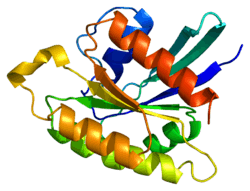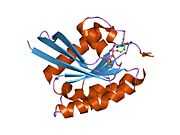RAP2A
Ras-related protein Rap-2a is a protein that in humans is encoded by the RAP2A gene.[1] RAP2A is a member of the Ras-related protein family.
Interactions
RAP2A has been shown to interact with RUNDC3A,[2] RASSF5[3] and RALGDS.[4]
References
- ↑ "Entrez Gene: RAP2A RAP2A, member of RAS oncogene family".
- ↑ Janoueix-Lerosey, I; Pasheva E; de Tand M F; Tavitian A; de Gunzburg J (Mar 1998). "Identification of a specific effector of the small GTP-binding protein Rap2". Eur. J. Biochem. (GERMANY) 252 (2): 290–8. doi:10.1046/j.1432-1327.1998.2520290.x. ISSN 0014-2956. PMID 9523700.
- ↑ Ortiz-Vega, Sara; Khokhlatchev Andrei; Nedwidek Maria; Zhang Xian-feng; Dammann Reinhard; Pfeifer Gerd P; Avruch Joseph (Feb 2002). "The putative tumor suppressor RASSF1A homodimerizes and heterodimerizes with the Ras-GTP binding protein Nore1". Oncogene (England) 21 (9): 1381–90. doi:10.1038/sj.onc.1205192. ISSN 0950-9232. PMID 11857081.
- ↑ Nancy, V; Wolthuis R M, de Tand M F, Janoueix-Lerosey I, Bos J L, de Gunzburg J (Mar 1999). "Identification and characterization of potential effector molecules of the Ras-related GTPase Rap2". J. Biol. Chem. (UNITED STATES) 274 (13): 8737–45. doi:10.1074/jbc.274.13.8737. ISSN 0021-9258. PMID 10085114.
Further reading
- Lerosey I, Chardin P, de Gunzburg J, Tavitian A (1991). "The product of the rap2 gene, member of the ras superfamily. Biochemical characterization and site-directed mutagenesis.". J. Biol. Chem. 266 (7): 4315–21. PMID 1900290.
- Pizon V; Chardin P; Lerosey I et al. (1988). "Human cDNAs rap1 and rap2 homologous to the Drosophila gene Dras3 encode proteins closely related to ras in the 'effector' region". Oncogene 3 (2): 201–4. PMID 3045729.
- Farrell FX, Yamamoto K, Lapetina EG (1993). "Prenyl group identification of rap2 proteins: a ras superfamily member other than ras that is farnesylated". Biochem. J. 289 ( Pt 2) (Pt 2): 349–55. PMC 1132174. PMID 8424780.
- Cherfils J; Ménétrey J; Le Bras G et al. (1997). "Crystal structures of the small G protein Rap2A in complex with its substrate GTP, with GDP and with GTPgammaS". EMBO J. 16 (18): 5582–91. doi:10.1093/emboj/16.18.5582. PMC 1170190. PMID 9312017.
- Janoueix-Lerosey I; Pasheva E; de Tand MF et al. (1998). "Identification of a specific effector of the small GTP-binding protein Rap2". Eur. J. Biochem. 252 (2): 290–8. doi:10.1046/j.1432-1327.1998.2520290.x. PMID 9523700.
- Nancy V; Wolthuis RM; de Tand MF et al. (1999). "Identification and characterization of potential effector molecules of the Ras-related GTPase Rap2". J. Biol. Chem. 274 (13): 8737–45. doi:10.1074/jbc.274.13.8737. PMID 10085114.
- Linnemann T; Geyer M; Jaitner BK et al. (1999). "Thermodynamic and kinetic characterization of the interaction between the Ras binding domain of AF6 and members of the Ras subfamily". J. Biol. Chem. 274 (19): 13556–62. doi:10.1074/jbc.274.19.13556. PMID 10224125.
- Ménétrey J, Cherfils J (2000). "Structure of the small G protein Rap2 in a non-catalytic complex with GTP". Proteins 37 (3): 465–73. doi:10.1002/(SICI)1097-0134(19991115)37:3<465::AID-PROT13>3.0.CO;2-O. PMID 10591105.
- de Rooij J; Rehmann H; van Triest M et al. (2000). "Mechanism of regulation of the Epac family of cAMP-dependent RapGEFs". J. Biol. Chem. 275 (27): 20829–36. doi:10.1074/jbc.M001113200. PMID 10777494.
- Husi H; Ward MA; Choudhary JS et al. (2000). "Proteomic analysis of NMDA receptor-adhesion protein signaling complexes". Nat. Neurosci. 3 (7): 661–9. doi:10.1038/76615. PMID 10862698.
- Traver S; Bidot C; Spassky N et al. (2001). "RGS14 is a novel Rap effector that preferentially regulates the GTPase activity of galphao". Biochem. J. 350 Pt 1 (Pt 1): 19–29. doi:10.1042/0264-6021:3500019. PMC 1221220. PMID 10926822.
- Gao X; Satoh T; Liao Y et al. (2001). "Identification and characterization of RA-GEF-2, a Rap guanine nucleotide exchange factor that serves as a downstream target of M-Ras". J. Biol. Chem. 276 (45): 42219–25. doi:10.1074/jbc.M105760200. PMID 11524421.
- Ortiz-Vega S; Khokhlatchev A; Nedwidek M et al. (2002). "The putative tumor suppressor RASSF1A homodimerizes and heterodimerizes with the Ras-GTP binding protein Nore1". Oncogene 21 (9): 1381–90. doi:10.1038/sj.onc.1205192. PMID 11857081.
- Song C; Satoh T; Edamatsu H et al. (2002). "Differential roles of Ras and Rap1 in growth factor-dependent activation of phospholipase C epsilon". Oncogene 21 (53): 8105–13. doi:10.1038/sj.onc.1206003. PMID 12444546.
- Strausberg RL; Feingold EA; Grouse LH et al. (2003). "Generation and initial analysis of more than 15,000 full-length human and mouse cDNA sequences". Proc. Natl. Acad. Sci. U.S.A. 99 (26): 16899–903. doi:10.1073/pnas.242603899. PMC 139241. PMID 12477932.
- Kuiperij HB; de Rooij J; Rehmann H et al. (2003). "Characterisation of PDZ-GEFs, a family of guanine nucleotide exchange factors specific for Rap1 and Rap2". Biochim. Biophys. Acta 1593 (2–3): 141–9. doi:10.1016/S0167-4889(02)00365-8. PMID 12581858.
- Ota T; Suzuki Y; Nishikawa T et al. (2004). "Complete sequencing and characterization of 21,243 full-length human cDNAs". Nat. Genet. 36 (1): 40–5. doi:10.1038/ng1285. PMID 14702039.
- Machida N; Umikawa M; Takei K et al. (2004). "Mitogen-activated protein kinase kinase kinase kinase 4 as a putative effector of Rap2 to activate the c-Jun N-terminal kinase". J. Biol. Chem. 279 (16): 15711–4. doi:10.1074/jbc.C300542200. PMID 14966141.
- Mitin NY; Ramocki MB; Zullo AJ et al. (2004). "Identification and characterization of rain, a novel Ras-interacting protein with a unique subcellular localization". J. Biol. Chem. 279 (21): 22353–61. doi:10.1074/jbc.M312867200. PMID 15031288.
- Dunham A; Matthews LH; Burton J et al. (2004). "The DNA sequence and analysis of human chromosome 13". Nature 428 (6982): 522–8. doi:10.1038/nature02379. PMC 2665288. PMID 15057823.
| |||||||||||||





